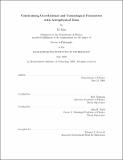| dc.contributor.advisor | Max Tegmark and Alan H. Guth. | en_US |
| dc.contributor.author | Mao, Yi, Ph. D. Massachusetts Institute of Technology | en_US |
| dc.contributor.other | Massachusetts Institute of Technology. Dept. of Physics. | en_US |
| dc.date.accessioned | 2009-04-29T14:49:10Z | |
| dc.date.available | 2009-04-29T14:49:10Z | |
| dc.date.copyright | 2008 | en_US |
| dc.date.issued | 2008 | en_US |
| dc.identifier.uri | http://hdl.handle.net/1721.1/45166 | |
| dc.description | Thesis (Ph. D.)--Massachusetts Institute of Technology, Dept. of Physics, 2008. | en_US |
| dc.description | This electronic version was submitted by the student author. The certified thesis is available in the Institute Archives and Special Collections. | en_US |
| dc.description | Includes bibliographical references (p. 189-199). | en_US |
| dc.description.abstract | We use astrophysical data to shed light on fundamental physics by constraining parametrized theoretical cosmological and gravitational models. Gravitational parameters are those constants that parametrize possible departures from Einstein's general theory of relativity (GR). We develop a general framework to describe torsion in the space time around the Earth, and show that certain observables of the Gravity Probe B (GPB) experiment can be computed in this framework. We examine a toy model showing how a specific theory in this framework can be constrained by GPB data. We also search for viable theories of gravity where the Ricci scalar R in the Lagrangian is replaced by an arbitrary function f(R). Making use of the equivalence between such theories and scalar-tensor gravity, we find that models can be made consistent with solar system constraints either by giving the scalar a high mass or by exploiting the so-called Chameleon Effect. We explore observational constraints from the late-time cosmic acceleration, big bang nucleosynthesis and inflation. Cosmology can successfully describe the evolution of our universe using six or more adjustable cosmological parameters. There is growing interest in using 3-dimensional neutral hydrogen mapping with the redshifted 21 cm line as a cosmological probe. We quantify how the precision with which cosmological parameters can be measured depends on a broad range of assumptions. We present an accurate and robust method for measuring cosmological parameters that exploits the fact that the ionization power spectra are rather smooth functions that can be accurately fit by 7 phenomenological parameters. We find that a future square kilometer array optimized for 21 cm tomography could have great potential, improving the sensitivity to spatial curvature and neutrino masses by up to two orders of magnitude, to k 0.0002 and m 0.007eV, and giving a 4s detection of the spectral index running predicted by the simplest inflation models. | en_US |
| dc.description.statementofresponsibility | by Yi Mao. | en_US |
| dc.format.extent | 199 p. | en_US |
| dc.language.iso | eng | en_US |
| dc.publisher | Massachusetts Institute of Technology | en_US |
| dc.rights | M.I.T. theses are protected by
copyright. They may be viewed from this source for any purpose, but
reproduction or distribution in any format is prohibited without written
permission. See provided URL for inquiries about permission. | en_US |
| dc.rights.uri | http://dspace.mit.edu/handle/1721.1/7582 | en_US |
| dc.subject | Physics. | en_US |
| dc.title | Constraining gravitational and cosmological parameters with astrophysical data | en_US |
| dc.type | Thesis | en_US |
| dc.description.degree | Ph.D. | en_US |
| dc.contributor.department | Massachusetts Institute of Technology. Department of Physics | |
| dc.identifier.oclc | 317980362 | en_US |
